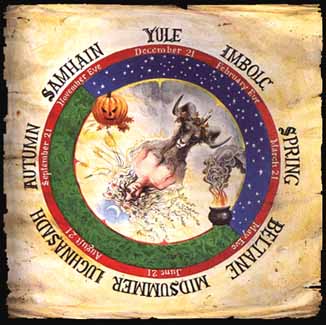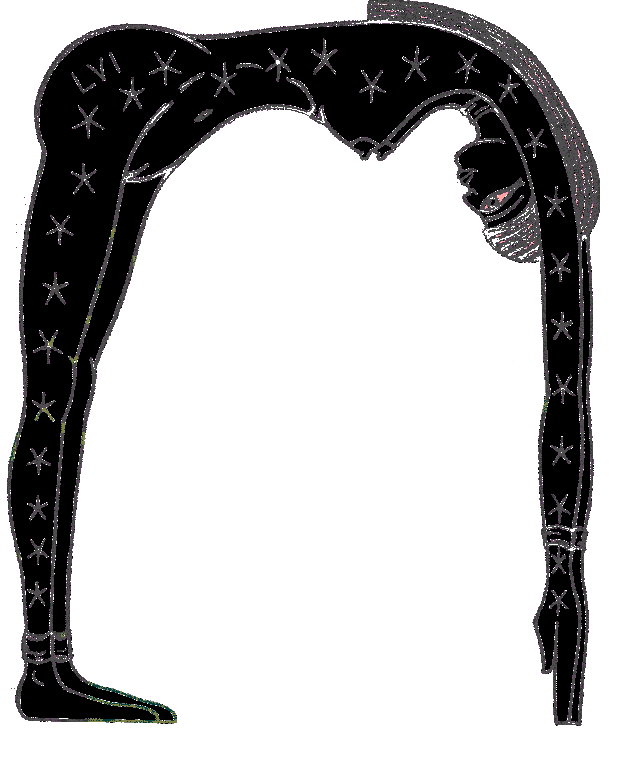Diverse
Valid Perspectives
The
theological teachings of the Church of Gnostic Luminism will harmonize and
include many of the disparate perspectives of Earth’s religious traditions;
among them the following:
 Animism, the
idea that all of Nature is alive and sentient;
Animism, the
idea that all of Nature is alive and sentient;
 Pantheism, the
realization that the Creator and the Creation are one;
Pantheism, the
realization that the Creator and the Creation are one;
 Polytheism, the view that the Creator manifests Itself to us as many distinct Gods and Goddesses;
Polytheism, the view that the Creator manifests Itself to us as many distinct Gods and Goddesses;
 Monotheism, the
realization that all of these Divine Manifestations are veils or partial
personalities of the One;
Monotheism, the
realization that all of these Divine Manifestations are veils or partial
personalities of the One;
 Monism, the
further realization that the One includes all that is, was, or can be; and
Monism, the
further realization that the One includes all that is, was, or can be; and
 Atheism, the realization that
the One is really None (or Void), since the universe is composed of pairs of
contrary opposites which mutually annihilate in combination [ (+) + (–) =
0 ]
...and the realization that anthropomorphic conceptions of God are false, illusory
constructs (“idols”) based on superstition.
Atheism, the realization that
the One is really None (or Void), since the universe is composed of pairs of
contrary opposites which mutually annihilate in combination [ (+) + (–) =
0 ]
...and the realization that anthropomorphic conceptions of God are false, illusory
constructs (“idols”) based on superstition.
The
holistic synthesis of these theological perspectives into a harmonious unity,
a seamless garment of Initiation, will comprise one of the major gifts that
the Church of Gnostic Luminism will offer to humanity.

Ecclesiastical Presentations
The
Church of Gnostic Luminism will promote and sponsor certain ceremonial
observances. Among them will be the following:
 Seasonal observances. As a means of attuning the individual’s
life with the ecosphere that we are each a part of, the ancient pagan
ceremonial observances of the turning points and mid-points of the
seasons will be adopted as official Church rituals. Presentations may
incorporate traditional and contemporary elements, and may make use of the
creative arts, music, dance, drama, poetry, incense, and whatever else is
deemed appropriate. The primary recognized seasonal observances will
include these:
Seasonal observances. As a means of attuning the individual’s
life with the ecosphere that we are each a part of, the ancient pagan
ceremonial observances of the turning points and mid-points of the
seasons will be adopted as official Church rituals. Presentations may
incorporate traditional and contemporary elements, and may make use of the
creative arts, music, dance, drama, poetry, incense, and whatever else is
deemed appropriate. The primary recognized seasonal observances will
include these:
 The Vernal Equinox, Ostara (Easter), the beginning of Spring,
March 21;
The Vernal Equinox, Ostara (Easter), the beginning of Spring,
March 21;
 Beltane, Mayday, the advent of Summer, May 1;
Beltane, Mayday, the advent of Summer, May 1;
 The Summer Solstice, Mid-Summer, June 21;
The Summer Solstice, Mid-Summer, June 21;
 Lammas or Lugnasadh, the end of Summer, August 1;
Lammas or Lugnasadh, the end of Summer, August 1;
 The Autumnal Equinox, the Harvest Festival, September 23;
The Autumnal Equinox, the Harvest Festival, September 23;
 Samhain or Hallowe’en, the night of the Thinning of the Veils
between the Worlds, October 31;
Samhain or Hallowe’en, the night of the Thinning of the Veils
between the Worlds, October 31;
 Yule, the Winter Solstice (the real “Christmas”),
December 21;
Yule, the Winter Solstice (the real “Christmas”),
December 21;
 Oimelc or Candlemass, the Day of Purification, February 1.
Oimelc or Candlemass, the Day of Purification, February 1.
 Lunar observance: four times in each 28-day Lunar month,
commemorating the four primary moon phases (new, first quarter, full, and
last quarter).
Lunar observance: four times in each 28-day Lunar month,
commemorating the four primary moon phases (new, first quarter, full, and
last quarter).
 Solar observance: four times each day, commemorating the four
stations of the Sun (sunrise, noon, sunset and midnight).
Solar observance: four times each day, commemorating the four
stations of the Sun (sunrise, noon, sunset and midnight).
Life Passage Ceremonies
These
rituals will commemorate important turning points in the lives of Church
members. Among them will be:
 Birth: a ceremonial welcome of newly incarnating souls into the
Church community;
Birth: a ceremonial welcome of newly incarnating souls into the
Church community;
 Puberty: a ceremonial recognition of the beginning of sexual
maturation and initiation into adulthood, marked in women by the first
menstruation, and in men by the first ejaculation;
Puberty: a ceremonial recognition of the beginning of sexual
maturation and initiation into adulthood, marked in women by the first
menstruation, and in men by the first ejaculation;
 Marriage: a ceremonial recognition of the intent of members of the Church community to unite in Holy Matrimony;
Marriage: a ceremonial recognition of the intent of members of the Church community to unite in Holy Matrimony;
 Menopause: a ceremonial recognition of the
“change of
life” and the end of the childbearing years, in which members are
recognized as Elders of the Church; and
Menopause: a ceremonial recognition of the
“change of
life” and the end of the childbearing years, in which members are
recognized as Elders of the Church; and
 Death: a ceremonial recognition of passage from Earth
incarnation.
Death: a ceremonial recognition of passage from Earth
incarnation.
Confirmation
Newly
recognized members of the Church will be publicly welcomed into the community
with feasting and celebration.
The Invocation
The
object of Gnostic Luminism for the individual is the absolute identification
of the human personality with the infinite/eternal gestalt consciousness of
All That Is — i.e. the total surrender of the Ego to the Universal Self (or
"God" if one prefers that term).
But
this surrender involves no loss to the individual; for, in reality, all
aspects of oneself that are not already one with the Universal Self are false
constructs made of illusion and dream.
From
this dream we now choose to wake.
We
bear no ill will or disdain toward the dream dimensions. We have languished at
our leisure in their fragrant fields, and our woes therein were but spice to
our passionate play. But the time has come to stir and rise into the light.
The
aspiration of the individual to this Awakening is formalized and declared to
the Universe by the Art of Invocation. When successful, the execution of this
Art is answered by a very real Response from the One invoked. Each aspirant
must study, practice, and become proficient in this Art. Each one must create
a pure expression of her/his intention to persevere in the Great Work to its
ultimate end. The tools of music, the visual arts, poetry, yoga, alchemy,
Qabalah, meditation, and the rest, are to be combined in this Creation, as
directed by each one’s own experience of Gnostic Illumination.
This
Work often takes many lifetimes; but by taking advantage of the technologies
gathered and taught by the Church of Gnostic Luminism, its attainment may be
gained as rapidly as one’s aspiration and volition will allow.
The
object of invocation, the One that the Invocation is addressed to (the
infinite-eternal Self of All Life) may be visualized and addressed in the
guise of any of the Gods and Goddesses of Earth’s many religious traditions,
according to individual inspiration and inclination.
In
the Canon of the Church of Gnostic Luminism, the primary archetype referred to
will be the Goddess of Infinite Space, the Great Mother (L. mater,
mother, the “matter” of which all Being is composed); as it is written in
the Book of the Law:
Sing
the rapturous love-song unto me! Burn to me perfumes! Wear to me jewels!
Drink to me, for I love you! I love you! I am the blue-lidded daughter of
Sunset; I am the naked brilliance of the voluptuous night-sky.
Classical
versions of the Invocation include Crowley’s Liber Samekh and the
invocation of the Holy Guardian Angel in The Sacred Magic of Abramelin the
Mage.
The
text below provides an example of one way the Invocation might be approached:

Let
there be incense,
and the music of flutes,
and the sound of drums.
* * *
O holy One, from which there is no other!
I stand now at the threshold of Thy temple.
No more do I run from Thee.
I have come
To offer myself at Thy altar.
I recognize the totality of Thy Spirit
As it permeates every particle of Matter
Of all that is, was, is to come, or might have been.
I know I am naught but Thee!
Therefore, if it be Thy will,
Take this vehicle which I am,
And let its every fiber
Reflect and manifest Thy light.
Let there be naught of Me
That is not Thee:
Now
And forevermore.
* * *
“There is no part of me that is not of the Gods.”

|


 BACK
BACK